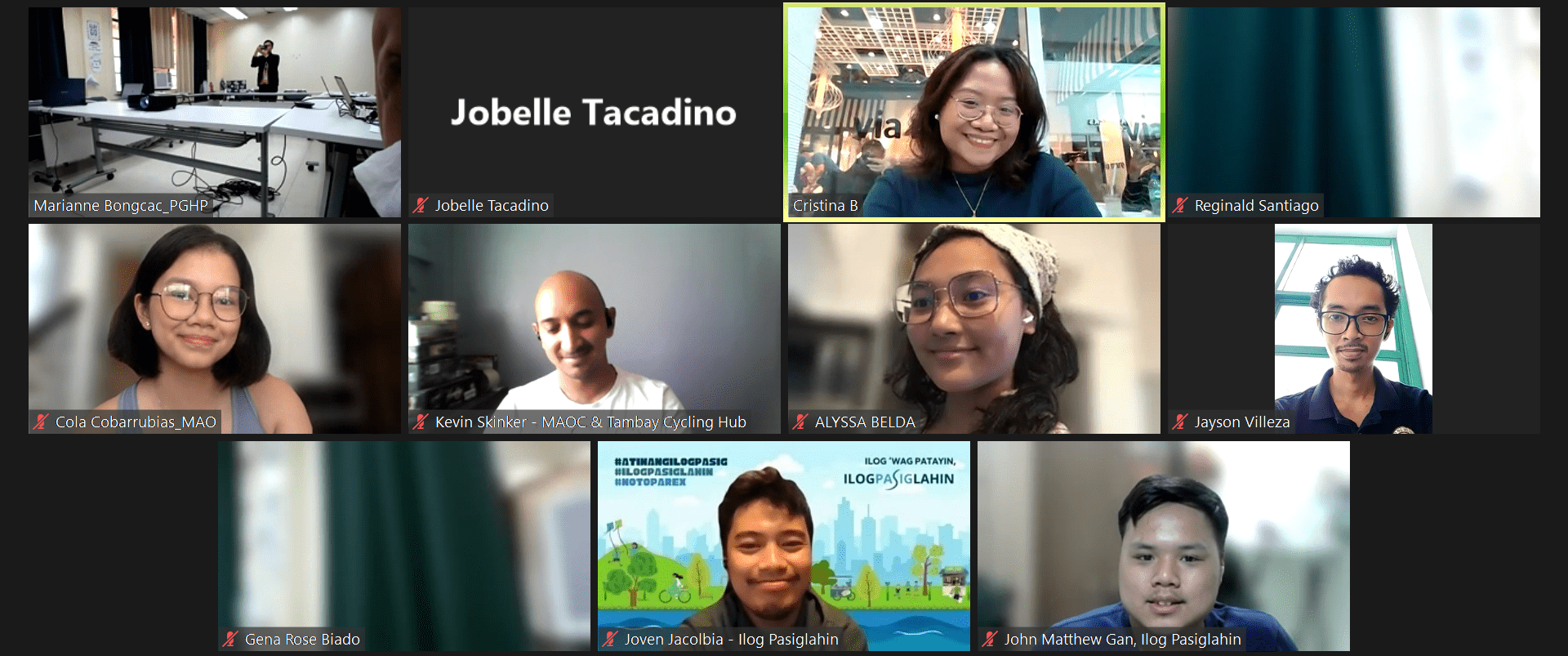

On February 7, members of the Planetary Health Philippines (PH2), consisting of Dr. Renzo Guinto and Marianne Bongcac from the Planetary and Global Health Program of the St. Luke’s Medical Center College of Medicine – William H. Quasha Memorial, and Dr. Danielle Guillen from the Asian Institute of Tourism of the University of the Philippines Diliman, convened with colleagues from the Move As One Coalition (MAOC) and the Health Promotion Unit of the Department of Health Metro Manila Center for Health Development (DOH-MMCHD) in an exploratory meeting to discuss the state of urban mobility and health in the Philippines.
The initial discussion revolved around the past and current policies, frameworks, convenings, and collaborations aimed at enhancing urban mobility and public health. Sir Reginald Santiago, Health Education Promotion Officer at the MMCHD shared that active mobility is one of the priority areas of the Health Promotion Framework Strategy 2023. One of their main initiatives is the Active Transport Playbook which is already being implemented in several LGUs. “Dito, na-highlight ni DOH na meron nang established, documented 70.6 km of active transport km range all over the Philippines. So one of it is Taguig with 61 km of bicycle lanes, and is planning to build another 30 km of bike lanes and slow streets,” Sir Santiago explained.
Meanwhile, Dr. Robert Siy, co-convenor of the Coalition raised the recent Joint Administrative Order on Healthy Public Open Spaces. “One of the initiatives also spearheaded, I believe by the DOH, was a joint administrative order signed by eight agencies on creating more public open space. Some of our partner CSOs worked also to help in the review and refinement of that administrative order. It’s something that we can also use to push more walkability and more public space that can be used also for walking and cycling. There’s also a very good provision there that enables DPWH as well as LGUs to convert roads that are currently used by vehicles into “pedestrianized” corridors so that they become car-free. […] So things like that could be some of the initiatives we can work on together,” Siy remarked.

Mr. Reginald Santiago presents the accomplishments of Taguig, one of the LGUs implementing the Active Transport Playbook.
Other notable initiatives discussed during the meeting include the Health Promotion Framework Strategy 2030, Walkability Summit, Annual Conference of the Transportation Science Society of the Philippines (TSSP), National Bike to Work Day, and People’s Streets, among others.
In terms of research, the group recognized studies on various aspects of the urban environment, transport, and mobility, however, there was a consensus that they were insufficient. Ms. Dinna Dayao, the communications consultant of the Coalition emphasized the significance of conducting walkability and “bikeability” audits in ensuring safer and more inclusive mobility for all: “This for me is a great injustice. There is a stoplight but vehicles are given much more time, I think 60 seconds at the stoplight while people are given 15 seconds. So that is one thing that I think if we, in a way, audit the institutions represented here on how accessible they are to people who are walking full of all abilities and ages.”

Dr. Danielle Guillen shares her insights and experiences as a transport planner and public transport user.

Marianne Bongcac expounds on other transport and health pathways using the main framework used in the Global Transport Challenges: Health and Wellbeing virtual course.
In addition, the role of solid waste management in transport planning was also highlighted by Dr. Guillen. “I’m a public transport user. As I mentioned, I go to UP via MRT. I normally take that because it’s easier, but one of the things I’ve noticed every time I walk is really the solid waste. […] I just want to forward it here that maybe we don’t recognize because of all the advocacy. But that is something that discourages the use of public transport if you see the dirt, right?” Guillen asked.
Furthermore, Ms. Bongcac and Ms. Cristina Batalla introduced comprehensive frameworks that encapsulate the pathways through which transport impacts health. They shed light on additional dimensions of this connection including noise pollution, social exclusion, urban heat islands, and subjective well-being. “I just wanted to add that, aside from air pollution, there’s also the issue of noise pollution. In one of the studies shared during the course, Rossi and colleagues found that a reduction in noise levels, they were able to quantify its effects and its results were more significant than actually reducing traffic risk, lessening road incidents,” Ms. Bongcac emphasized. Both were participants in a virtual course offered by the Transport Studies Unit at the University of Oxford from September to October 2023.
Moving forward, the group recognized the importance of
utilizing existing initiatives and networks of allies and empowering local champions to advance the agenda of people-centric mobility in the Philippines. It was emphasized that evidence and best practices need to be documented, and collaboration and coordination with academia should be enhanced to ensure well-informed policies and governance decisions. Additionally, there was a recommendation to train media champions to communicate mobility issues through a health lens. Dr. Guinto underscored the need for advocacy in a positive manner, suggesting that a health lens makes the campaign more human and encourages people to act. He emphasized the importance of collaboration, stating, “Let’s harness the rigor of academia, the passion and the lived experiences of civil society, and the influence and resources of government.”

0 Comments